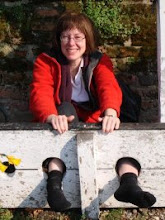I thought that I would tell you in more detail about our BQSG Seminar in Burnley. This area has a rich textile history and produced most of the world's textiles in the 1800's.
On Friday, we had a visit to Gawthorpe Hall. Half of the group had a tour of the house while the other half examined the Rachel Kaye-Shuttleworth Textile Collection. Unfortunately, we were not allowed to take photographs in the house. It is is late Tudor/early Jacobean in date although heavily restored in Victorian times. There are some interesting displays of textiles in the house. Rachel Kay Shuttleworth believed that crafts were vital to developing a balanced personality, and also important in helping rehabilitate people. She opened a crafts school and the collection was supposed to act as examples for study.
The Master bedroom has a large tester bed with bed curtains worked by Rachel KS. The room looks out over the Calder River.
After our tour of the house we had lunch and then looked at the textiles collection - a selection of quilts were brought out for us to see. Some were very old and some were more recent. Although we were allowed to take photos for our own use, we undertook not to use them on any website....
I had gotten a lift with David and Susan L - and we just had enough time to go to the Queen Street Mills, a weaving museum just outside Burnley. As we had less than 45 minutes left before closing time, we were not charged an entrance fee!
Another loom. Most of the cotton cloth woven here when the mill was working was white goods, and the cloth went off to printing firms to be turned into stylish cloth.
The mill sees a lot of school parties visit; some of the looms are working and produce cloth: calico, teatowels and a textured cloth. These are prayer shawls that are sent to a dealer in Israel.
I think that this is the beaming machine, which winds the cotton thread (bought in) onto bobbins for use in the looms.
As we were wandering around, we fell to chatting with an employee who was trying to repair one of the looms. Of course each loom is different and needed a skilled employee to keep it in working order. And, mills often modified the looms for their own products. No users manuals here. So getting them up and running is rather trial and error. He was trying to get a loom to produce teatowels without weaving faults - when it is fixed, they will be producing teatowels with "Queen Street Mill" woven down the centre.
He did open up the large weaving room for us to view. Although the looms were still, this was very evocativee.
This room has 360 looms remaining. It originally had 1000 (the rest have been scrapped). Burnley had over 100,000 such looms and Lancashire in total, about a quarter of a million. So the Lancashire textile industry was much more sophisiticated and had received more investment than the Welsh weaving industry. Compared to the Welsh woollen mill, this mill was much bigger and more capital intensive.
When the looms were operating, the noise was deafening. Workers soon became deaf - either from the noise or from ear infections due to dirty earplugs. A miming language was needed for communication - and the weavers were adept at lip reading as well.
The looms are arranged in 4s, 6s and 8s. There was an apprentice system - new apprentices were put with an experienced weaver in a group of four looms - two machines for the weaver and two for the new person. The weaver got paid for teaching. As the apprentice became more experienced and needed less supervision, the weaver took on four and then six machines. What I found incredible is that both had only 15 seconds to check each machine before going on to the next - an endless round of running the looms. All the looms produced cotton fabric that was 36 inches wide. Lots of dust and fibre was produced.
The next two days were taken up with the seminar and the presentation of papers. More about these later.










Wow!!
ReplyDelete